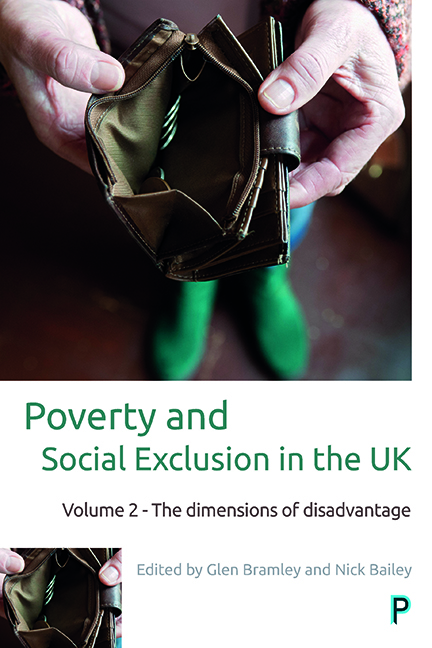two - Living standards in the UK
Published online by Cambridge University Press: 12 April 2022
Summary
Introduction
Much research into poverty, deprivation and social exclusion is concerned with the living standards of individuals and households (Cribb, Hood and Joyce, 2015), how equally living standards are distributed, and how this has changed over time (Brewer and O’Dea, 2012). Yet there is little consensus on what constitutes ‘living standards’, or how they can be measured or utilised to inform policy making (Hobbs, Marrinan and Kenny, 2015). Instead, there has been an historic reliance on income-based measures of poverty. Although these measures are widely understood by policy makers, they are difficult to translate into real-life economic, material and social conditions of life (Barnes et al, 2012; Wood et al, 2012). Moreover, the focus on the lower end of the income spectrum serves to mask the experiences of the majority of the population who do not fall below the poverty threshold, including a minority just above this threshold who may in fact share many of the deprivations of those just below it. In addition, different measures of poverty identify slightly different groups of people. For example, there are discrepancies between low-income poverty and material deprivation measures (Nolan and Whelan, 1996; Perry, 2002; Bradshaw and Finch, 2003). Put simply, individuals and families with similar levels of ‘resources’ (for example, disposable income) may have very different experiences of or ‘outcomes’ from struggling financially, ranging from, for instance, not being able to go on annual holiday, facing accommodation difficulties, or specific problems in their local area.
Previous research into living standards has also tended to rely on objective measures of economic advantage and disadvantage in the UK, whereas more recently there has been an increase in the use of both objective and subjective measures (subjective poverty and financial security, for example). This rise in subjective assessments of poverty or life conditions resulted not only from an increase in the availability of data on these but also a clear sense that people's perceptions are needed in order to inform our understanding of the multidimensional nature of welfare (Veenhoven, 2002; Ravallion, 2012; OECD, 2013). The Stiglitz-Sen-Fitoussi report (2009) concluded that it is possible (and indeed crucial) to collect meaningful and reliable data on subjective as well as objective well-being.
- Type
- Chapter
- Information
- Poverty and Social Exclusion in the UK Vol 2The dimensions of disadvantage, pp. 57 - 90Publisher: Bristol University PressPrint publication year: 2017



